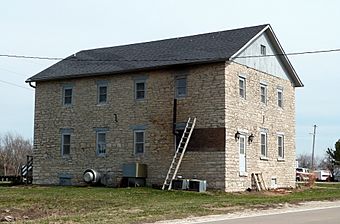Dennis Melcher Pottery and House facts for kids
Quick facts for kids |
|
|
Dennis Melcher Pottery and House
|
|

The Dennis Melcher Pottery in 2013.
|
|
| Location | 22981 and 22982 Agency Rd. Danville, Iowa |
|---|---|
| Built | 1923-1924 |
| Architectural style | Italianate |
| NRHP reference No. | 03000832 |
| Added to NRHP | August 28, 2003 |
The Dennis Melcher Pottery and House are old, important buildings near Danville, Iowa, United States. They tell the story of a German immigrant named Dennis Melcher. He built a successful pottery business here in the 1800s. These buildings are now listed on the National Register of Historic Places. This means they are recognized as special and worth preserving.
Contents
The Story of Dennis Melcher's Pottery
From Germany to Iowa
Dennis Melcher was born in Baden, Germany. His brother Edward was also born there. Their father was a potter, someone who makes things from clay. In the 1840s, Dennis and Edward moved to Burlington, Iowa. Dennis wanted to continue his family's craft. He opened his first pottery business in Burlington in 1844.
Finding the Right Clay
The Melcher brothers soon found a special type of clay. This clay was located near Agency Road. It was right on the border of Des Moines County and Henry County. Dennis bought almost 20 acres of land in Danville Township. This land was perfect for his new business.
Building the Business
Dennis Melcher built a limestone building for his pottery business. He also built a house across the road for his family. In 1851, his new pottery shop opened. Dennis worked hard at his pottery until he passed away in 1879.
What Was Made Here
The pottery made many useful items for homes and farms. These included crocks (large jars for storing food). They also made churns (for making butter). Other items were kitchen jugs and canning jars. Dennis Melcher's pottery also produced bean pots and flower pots. It is possible they even made dinnerware, like plates and bowls.
A Historic Landmark
The Dennis Melcher Pottery and House are very important. They show us how people lived and worked long ago. Because of their history, these buildings were added to the National Register of Historic Places in 2003. This helps protect them for future generations.



